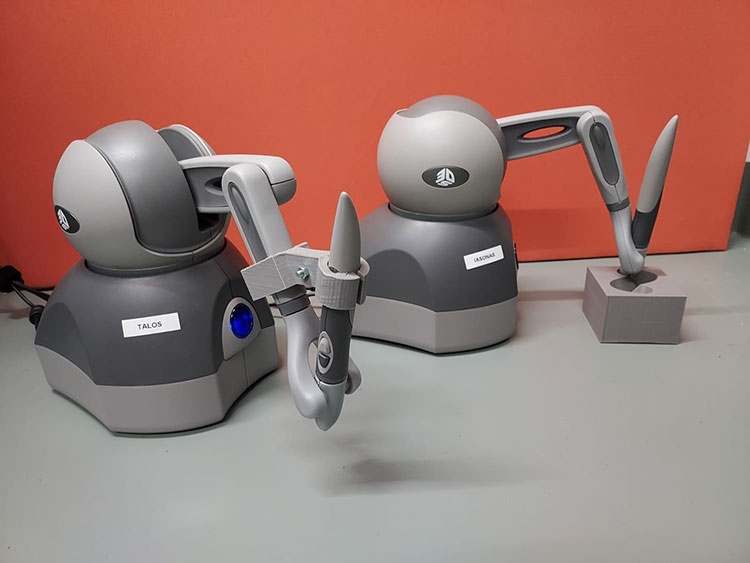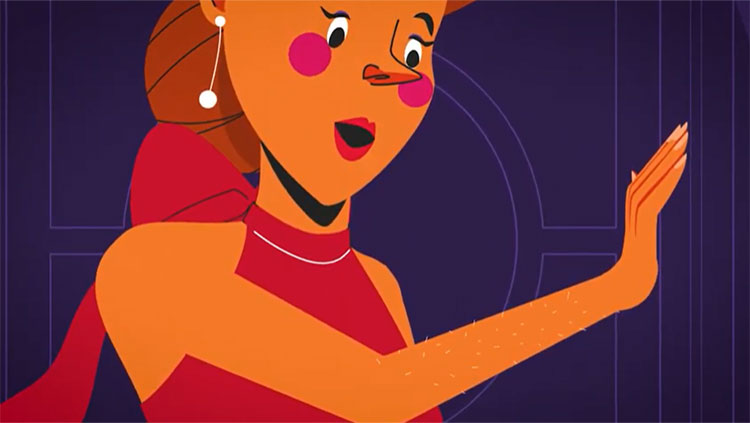Unraveling the Mysteries of Tickling
- Published8 Feb 2021
- Author Hannah Zuckerman
- Source BrainFacts/SfN

In 2019, two robots at Sweden’s Karolinska Institutet, each armed with a stylus, helped humans do something they can’t do on their own: make their touch feel more ticklish. Konstantina Kilteni, assistant professor in the department of neuroscience, used the robots to study self-generated touch. The robots served as mediators — when a participant moved the first robot, the second robot touched the participant’s arm. The team then blindfolded participants and introduced a small delay between the participant moving the first robot and the second robot’s touch. Why? Because tickle has a lot to do with how and when we predict touch.
From her previous studies, Kilteni knew self-generated touches feel weaker than external touches. But, a self-generated touch feels more intense when researchers introduce a small delay. Kilteni wanted to examine two things. Firstly, would participants feel the delayed touches were less intense if they grew used to the delays? And secondly, after removing the delays, would the non-delayed self-generated touch feel stronger and more ticklish? The team found evidence supporting both these questions.
This was Kilteni’s first study on tickle attenuation — how the brain dampens a self-generated touch so it doesn’t feel as ticklish compared to someone else tickling you. BrainFacts.org asked Kilteni what happens in the brain when we are tickled and why we can’t give ourselves the same giggles from the tickles.
How does our brain perceive tickling?
There are two types of tickling. Knismesis is a light pressure that induces an itchy sensation. Try stroking your fingers along your arm and you’ll get a moving, itch sensation. Like any touch, this sensation activates somatosensory areas as well as the thalamus — a relay area where the sensory information arrives. Other studies have found knismesis activates motor areas, which are related to the desire to scratch, and areas that encode emotional aspects of itch, like the insula.
Gargalesis, the other type of tickling, is induced by deep pressure on specific areas like the armpits or ribcage. It’s typically accompanied by laughter. We don’t know how the brain specifically processes this sensation and what exact pathway it follows.
Why are people ticklish?
Scientists found knismesis in many species. From an evolutionary perspective, the itchy sensation tells you something’s crawling on your skin that you should remove.
We don’t know the purpose of gargalesis, so it’s difficult to answer. We don’t know if it’s a social response or a reflex reaction that serves something we haven’t yet identified.
Why can’t you tickle yourself?
You can induce knismesis — the itchy-tickly sensation — with a feather or your fingers to a certain extent. Thanks to your cerebellum, you can’t induce gargalesis yourself. This brain area receives signals from the sensory system, the motor system, and other areas. It then regulates movements. We’ve found the cerebellum can tell when you or someone else is producing a touch. So, when you try tickling yourself, your brain already knows when, where, and how strong the touch will be. When the brain can make this prediction, it dampens the activity in the somatosensory cortices, making the touch feel less ticklish. When someone else tickles you, your brain can’t make those predictions so the sensation feels much stronger.
Some scientists speculate the brain does this so it can dedicate more processing resources to external-generated stimuli. An external touch is more likely to be harmful or threatening than a self-generated touch.
Why do we laugh when we get tickled?
It’s not clear whether tickling laughter is similar to humorous laughter. It’s not well established if we laugh because we’re having fun since many people don’t like being tickled but still laugh.
There’s a theory that tickling serves for social bonding. Scientists have observed mothers often tickle their babies, and this helps form their connection. But many people don’t like being tickled. We like hugs, which is a social bond, but why would it serve as social bonding if people don’t like getting tickled?
In 1999, researchers at the University of California examined how people experienced getting tickled by a person or a machine. They found participants were tickled by both a human and a machine to the same extent. This gives some evidence that tickling is a low-level reflex response. Now, my team and I are interested in moving to the field of ticklishness to understand the mechanisms and purpose of tickling.
What are some difficulties to studying tickling?
We don’t have an automated way to induce gargalesis. With a robot we can study knismesis but gargalesis is tricky. We also don’t have an objective measurement of how tickly something feels. We can ask participants to rate how tickly they perceive the stimulus, but it would help to have an objective measurement.
Another methodological difficulty arises during neuroimaging studies. If we induce tickling, participants may start moving around and laughing. Moving around affects the signal we’re able to capture.
BrainFacts.org welcomes all your brain-related questions.
Every month, we choose one reader question and get an answer from a top neuroscientist. Always been curious about something?
Please submit your question by filling out this form.








